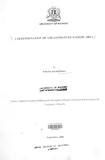| dc.description.abstract | The precise geoid determination is one of the main current geodetic problems in Kenya. This is
because Global Positioning System (GPS) defined coordinates require geoid heights so as to be
compatible to orthometric heights that are used in practice. The geoid is the reference surface
for orthometric heights, which are the functional heights for mapping, engineering works,
navigation, and other geophysical applications.
In this study, a local geoid has been determined by geometric approach. The geoid heights are
derived from geodetic and orthometric heights. The geodetic and orthometric heights in this
study are referred to the World Geodetic System 1984 (WGS84) and the local mean sea level
respectively. Nineteen points leveled by both GPS and precise leveling techniques in the area
of study have been used.
In order to express the local geoid as a function of the local plane coordinates, it is deemed
necessary to determine three-dimensional transformation parameters between WGS84 and Arc-
Datum 1960 (local datum). Seven triangulation points have been used for the determination of
transformation parameters in the area of study.
The geoid height is expressed as a function of the local plane coordinates through a biquadratic
surface polynomial. The coefficients of the biquadratic polynomial are determined by two
methods: Least Squares (LS) and Least Squares Collocation (LSC) using 14 GPS/Leveling
points. Five points have been used for testing the results. It is found that the coefficients
determined by LS and LSC model the geoid at the same level on the test points. However, LSC
technique provides stochastic parameters to the predicted geoid heights. Earth Gravity Model
of 1996 (EGM96) has also been used to determine geoid heights although it compares poorly at
the test points.
The experience with Nairobi area geoid indicates that modelling the geoid by a biquadratic
polynomial is simple and it works well. The geoid heights obtained by biquadratic polynomial
(determined by LS and LSC) compare favourably on the test points with root mean square and
standard deviation of +1cm in the area of study.
A MATLAB program (RUN.M) has been developed to functionalise the use of the
transformation parameters and the polynomial. The program interacts with the user through a
user interface. From the observed WGS84 coordinates, the local Universal Transverse Mercator
(UTM) coordinates (N, E) on Arc-Datum 1960 are computed followed by the interpolation of
geoid height and subsequently the orthometric height of a given point within the area of study.
The extents of the area of study are: latitudes (10 8' 00" S to 10 25' 18" S) and longitudes (360
38' 55" E to 360 58' 24" E).
The results show that if geoid heights are accurately determined, then a biquadratic polynomial
can be used for geoid modelling. The combination of transformation parameters and
biquadratic polynomial is therefore a possible way of enabling the use of GPS for local survey
work. | en |

